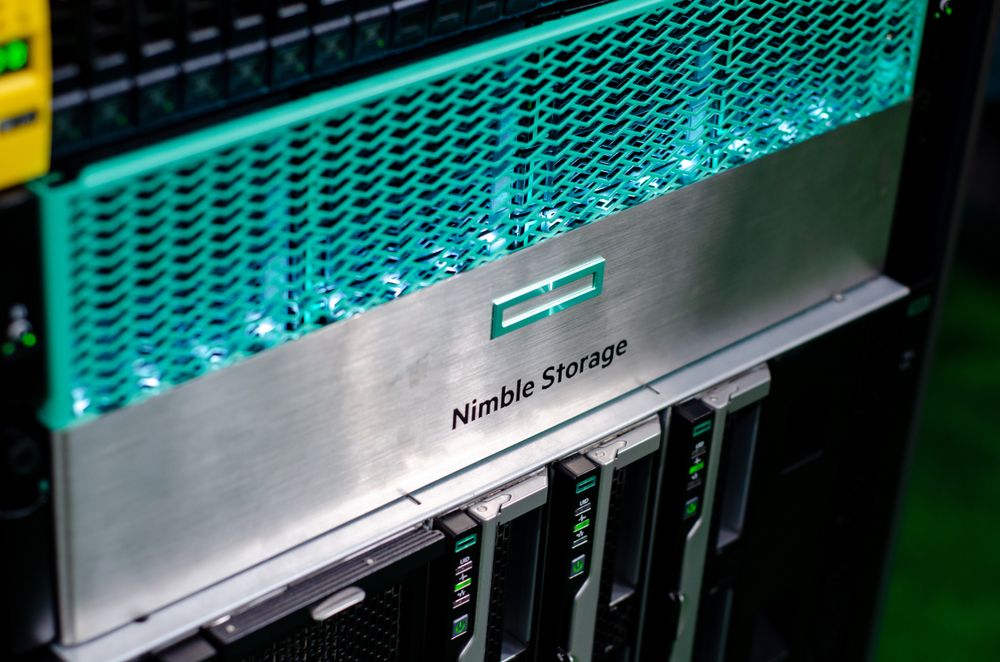Embracing the Future with Nimble Storage
Siloed IT infrastructures are no longer cutting it. It’s time to turn to more advanced storage solutions. Learn more.
The cloud may once have been the best choice for storage, but hyperconverged infrastructure is quickly becoming the frontrunner in the space. Learn why.
Cloud services have been popular for years, whether organizations are using public clouds, private clouds, or some combination of the two. Phrases like “hybrid cloud” and “multi-cloud” — once entirely foreign concepts — have now become part of the common vernacular for business leaders looking for the next great storage solution.
For many people, the rise in popularity and excitement about the cloud has made pure cloud environments seem like the ideal way to store information and deploy applications no matter what challenges may arise from that approach. While these pure cloud environments may be a good fit for some organizations, in many cases a hyperconverged infrastructure (HCI) can actually be a better fit.
HCI is a replacement for legacy infrastructure systems consisting of separate storage arrays, servers, and storage networks. Instead, HCI converges your entire datacenter stack (including storage, storage networking, compute, and virtualization) so it can be controlled by a single datacenter management platform and a hypervisor. It combines commodity datacenter server hardware with locally attached storage devices (either spinning disk or flash) to create flexible virtual building blocks. Those building blocks are powered by a distributed software layer designed to eliminate many of the common pain points associated with legacy systems.
So what makes a hyperconverged infrastructure a better choice than pure cloud (or legacy systems) for many businesses? And how do you choose the right HCI solution for your business? Read on for the answers to these questions and many more.
Cloud services certainly have advantages (especially when compared to legacy systems). Their flexibility and scalability has made them appealing to a wide range of businesses over the years — particularly those with changing needs who require a solution that can dynamically adapt with them. Unfortunately, cloud computing comes with some challenges as well. Building and deploying new applications in public clouds can be difficult, often requiring specialized skills that few people have. Cloud resources can also get very expensive, very quickly when compared to on-premises infrastructure options. Still, many businesses are hesitant about leaving their cloud infrastructure behind entirely.
The great thing about the hyperconverged infrastructure is that it offers the same advantages as the cloud — without the costs. That’s because HCI is underpinned by many of the same distributed systems technologies as public clouds. That enables organizations to build private clouds that bring all the benefits of cloud computing right into their data centers. The result is that, with HCI, you can create an easy on-prem deployment of a cloud-like infrastructure — but one that is cheaper and more secure. So if you’re looking for a better way to establish a cloud — whether it’s public, private, or hybrid — HCI offers a simple, highly-scalable, structured, and cost-effective way to do it.
Plus a hyperconverged infrastructure comes with other bonus advantages that make it an easy-to-use solution for businesses of all kinds. It offers a highly efficient workflow, along with excellent deployment operations, backups, and disaster recovery. For businesses that are looking to maintain the advantages they find in their cloud infrastructures or their legacy, on-premises solutions while leaving behind the problems that can plague those two systems on a daily basis, HCI is the perfect solution.
When it comes to the best hyperconverged infrastructure, there are a number of options to choose from. Two that stand above the rest are HPE SimpliVity and HPE Nimble Storage.
SimpliVity
Hewlett Packard Enterprise’s SimpliVity platform has transformed the way organizations store their data thanks to its hyperconverged infrastructure. It offers compute, networking, storage, and other datacenter services in a single hyperconverged stack that delivers enterprise-level data protection, performance, and resiliency. By offering always-on compression, automated storage utilization, and policy-based VM-centric management, HPE’s SimpliVity powers some of the most efficient datacenters anywhere.
SimpliVity stands out from other HCI solutions thanks to three key features: its global VM-centric management and mobility, its built-in resiliency (backup and disaster recovery), and its guaranteed data efficiency. Plus, SimpliVity converges your entire IT stack in each node. That convergence is part of what makes SimpliVity a great choice for businesses who expect to scale up in the future, no matter their size now.
Nimble Storage:
HPE’s Nimble Storage is an intelligent, self-managing storage solution that powers everything from test/dev, to VMs, to containers — all while extending across your hybrid cloud with ease. At the center of Nimble Storage is the array. The platform’s arrays are built with simplified storage management in mind. In line with the goal of simplicity, HPE makes it easy for customers to choose what kinds of arrays they want, whether they’re all flash or a mix of flash with other cost-effective storage options.
Nimble Storage’s All Flash Arrays are built for speed and are typically targeted at latency-sensitive or high-performance workloads. The Adaptive Flash Arrays, on the other hand, are built to achieve optimal price as well as performance. These arrays combine cost-optimized disk drives with high-performance flash to deliver the performance you need while saving you money in areas where you don’t need the highest speeds. Whichever array option you choose, you will also get the benefits of Nimble Storage’s quality data recovery features as well as its cloud-readiness.
When it comes to choosing the best data storage solutions, flexibility, simplicity, and cost are always top priorities. People often think that they need a pure cloud solution because that seems like the cool option of the moment. But the reality is that, for many companies, it makes far more sense not to have all their applications in the cloud. Some applications may require local storage, or some might come with cybersecurity implications that make the cloud a bad choice.
Solutions like HPE SimpliVity and HPE Nimble Storage that leverage a hyperconverged infrastructure can deliver the flexibility and power you need in a storage solution while also offering cost savings and simplicity that can’t be attained through the cloud or through traditional legacy systems.
At Turn-key Technologies, Inc. (TTI), we have a lot of experience working with HCI. We know that understanding how it will work in your environment can be a challenge. Our experts are here to help you tackle that challenge head-on. We can take you through the advantages of switching to a hyperconverged infrastructure instead of pure cloud or legacy systems and we can help you determine which HCI platform is right for you. Contact us to start learning how HCI can improve your storage.

Siloed IT infrastructures are no longer cutting it. It’s time to turn to more advanced storage solutions. Learn more.

As hyper-converged IT infrastructures become increasingly mainstream, enterprises must brush up on the approach lest they fall behind industry...

Everyone is buzzing about “hybrid cloud” strategies, but clarity around that conversation is being muddled by widely-held misunderstandings of this...